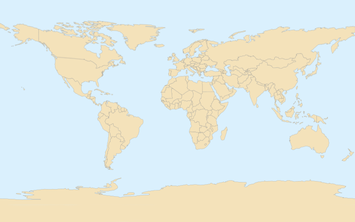
What parts of the world have given rise to the most successful entrepreneurs? This is a question which is answered in the superentrepreneurs project. This project is about studying high-end entrepreneurship and focuses on the close to 2 500 individuals in the world who have built up billion-dollar fortunes, by creating new companies or growing small businesses into large successful ventures. The point is to measure the tip of the iceberg; by looking at superentrepreneurs, we can understand which countries are more conducive to free enterprise in general.
Overall, it is the USA which is leading the world in high-impact entrepreneurship. There are 3.1 superentrepreneurs (self-made billionaire entrepreneurs) per million adults in the USA, far outpacing other large economies. As comparison there are 1.7 superentrepreneurs per million adults in Canada, and 1.1 in Oceania. China has a higher concentration of new high-impact entrepreneurs (0.9) compared to Europe (0.8). Given the level of economic development in Europe, this part of the world is lagging in high-impact entrepreneurship. The lack of superentrepreneurs reflects that Europe still largely relies on old fortunes, rather than new ones founded through new companies.
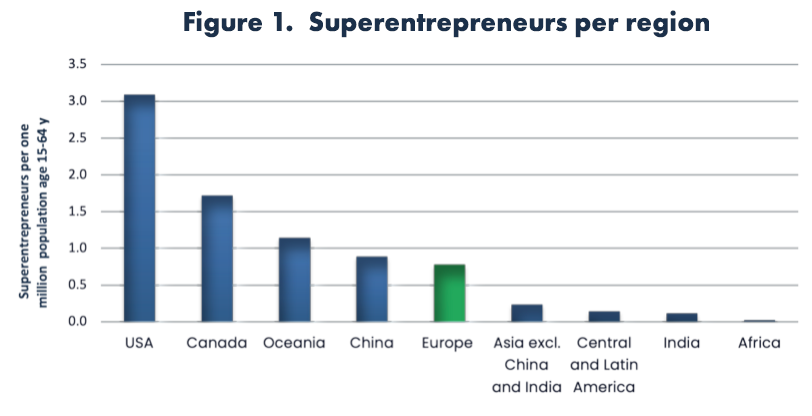
At the same time, there is a European entrepreneurial paradox. The paradox is that half of the countries on the top-10 list, with most superentrepreneurs per capita, are found in Europe — while Europe, as a whole, has a relatively limited concentration of superentrepreneurs. Singapore has the highest concentration of superentrepreneurs in the world, followed by Switzerland, one of the leading knowledge economies of Europe. Cyprus, Sweden, Ireland, and the UK are four other European economies which are included in the global top-10. Cyprus is a small country with advantageous tax system, Sweden spends most on research and development in Europe, and Ireland has a free business approach which has attracted many tech companies — not least from the USA — to the fast-growing island nation. The UK is the most entrepreneurial of the large economies of Europe.
Yet the other large European economies, such as France, Germany, Italy, and Spain, have few superentrepreneurs. The eastern European countries lack the size, and market development, to give rise to many superentrepreneurs. Therefore, Europe has a lower concentration of high-impact entrepreneurs, per million adults, even compared to China. Still, Europe does have a higher standard of living than China, but the difference is that much of the wealth in Europe is old, while much of the wealth in China has been founded in the past generation.
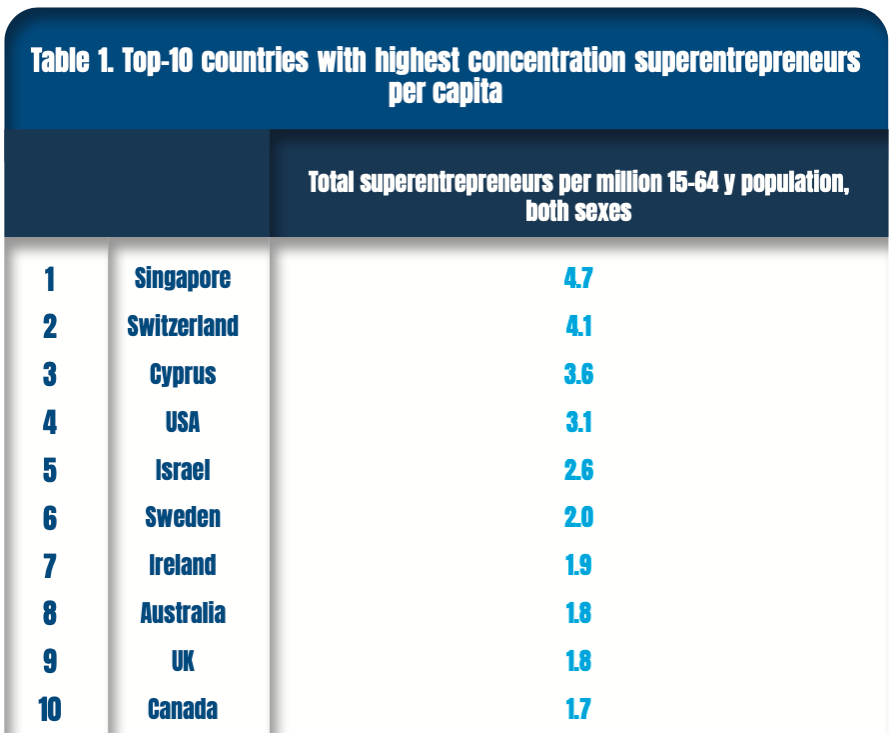
Superentrepreneurs push for various forms of innovation, in the businesses that they create. The main benefit to society is job creation, as one more superentrepreneur per million adult inhabitants is linked to 0.88 percentage points lower unemployment. The effect is strongest for the broad middle class with intermediate education. For those who have high school education and perhaps some additional work training, but not college or university degrees, one more superentrepreneur per million adults is linked to 1.1 percentage points lower unemployment.
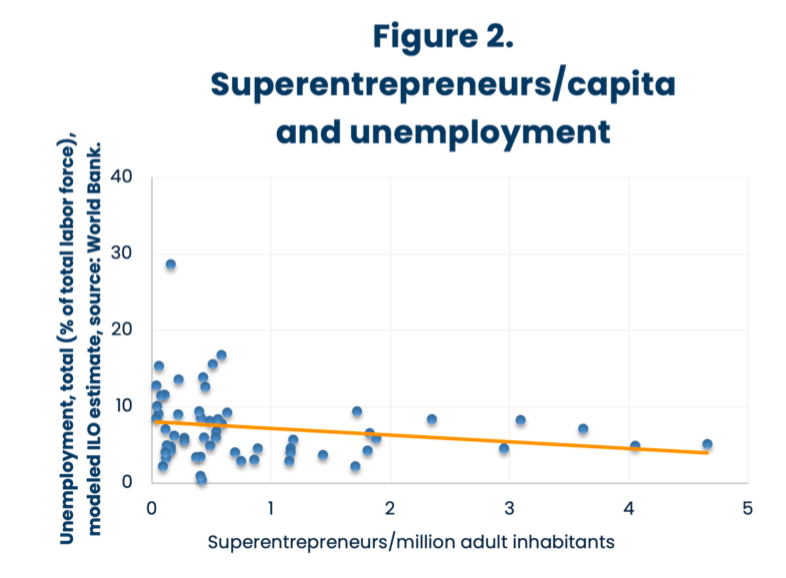
Sometimes the rate of self-employment is used as a measure for entrepreneurship. Yet, the two concepts are quite different. The global trend is that those countries which have a lower level of economic advancement have many self-employees, but few superentrepreneurs. In India, for example, 76 percent of adults are self-employed, and merely 0.1 per million adults are superentrepreneurs. In the US on the other hand, 6 percent of the adult population is self-employed, while there are as many as 3.1 superentrepreneurs per million inhabitants. In countries with well-functioning market economies, entrepreneurs create jobs for large groups of people, while in countries with limitations on free enterprise, many become self-employed out of necessity.
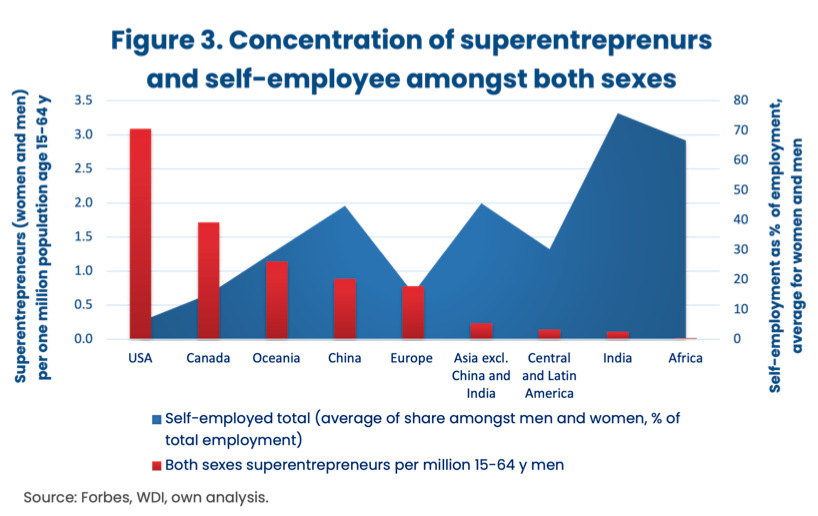
Most superentrepreneurs are men, and only 5 percent of the close to 2 500 superentrepreneurs of the world are women. Of the Chinese high-impact entrepreneurs, as much as 8 percent are women. Africa, as well as Central and Latin America, have few superentrepreneurs, but a quite high share of them are women. In the US, 4 percent of the superentrepreneurs are women and the figure is below 3 percent in Europe as well as in Canada. In Oceania, all superentrepreneurs are men. The pattern we see is that parts of the world that are open for entrepreneurship in women dominated fields such as education, health care, and elderly care, are those where many women become self-made billionaires.
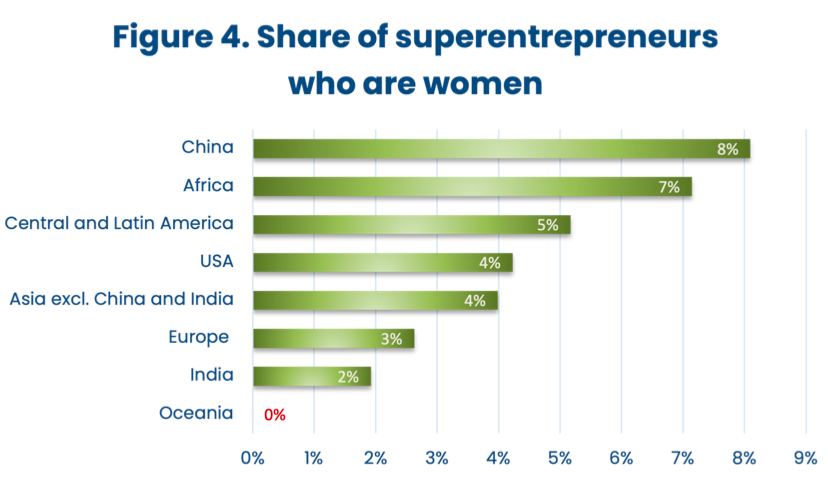
We find that numerous policies are positively linked to fostering superentrepreneurs. Strengthening property rights, making it easier to run businesses, lowering the taxes on profits and capital gains, and improving the knowledge level in schools, are the changes that are needed for countries to have more high-end entrepreneurs. Again, it is all about measuring the tip of the iceberg. Countries that strive to gain more superentrepreneurs, need to open for entrepreneurship friendly policies in general. While this will result in some new superentrepreneurs, it will also lead to many new medium sized businesses that thrive. Encouraging high-end entrepreneurship is linked to job growth, and technological development. Even for those countries that are already faring well, there is good reason to continue pursuing entrepreneurship friendly policies.
Authors:
Nima Sanandaji, Director European Centre for Entrepreneurship and Policy Reform
Klas Tikkanen, Chief Operating Officer Nordic Capital
Kristoffer Melinder, Managing Partner Nordic Capital
Lead image: world map via Wikimedia.













India?
Strikingly low numbers for a country with so many rising stars at home and abroad. Maybe the key is PER CAPITA...and also the low percentage of women.